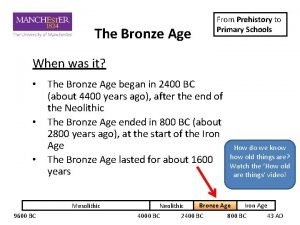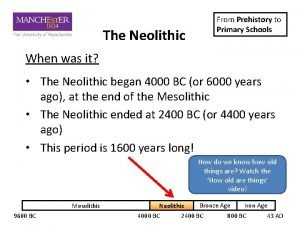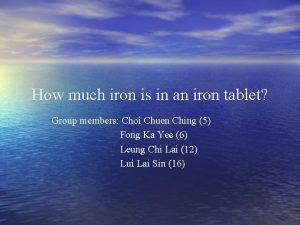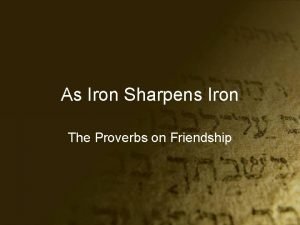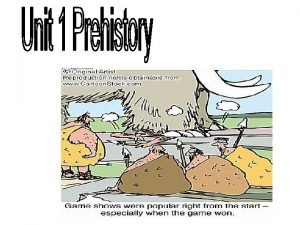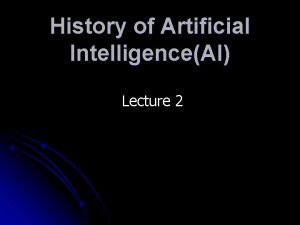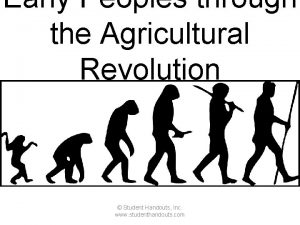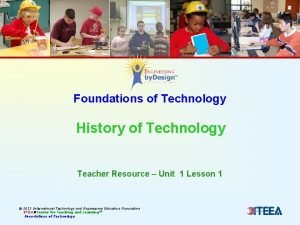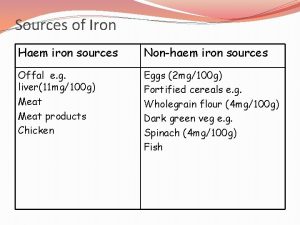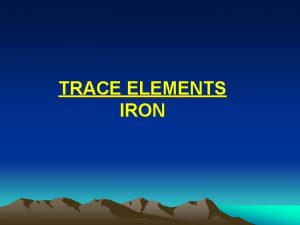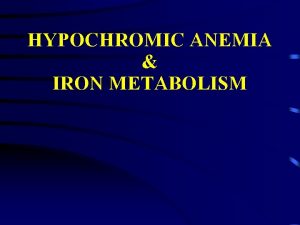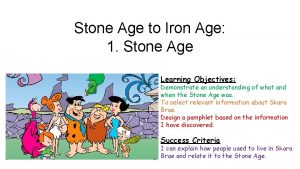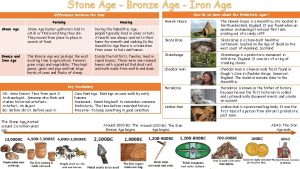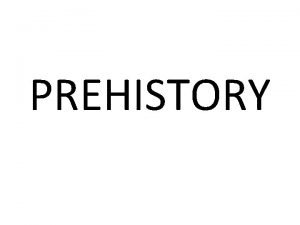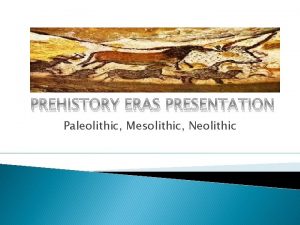The Iron Age From Prehistory to Primary Schools














- Slides: 14

The Iron Age From Prehistory to Primary Schools When was it? • The Iron Age began in 800 BC (about 2800 years ago), after the end of the Bronze Age • The Iron Age ended in 42 AD (when the Romans arrived!) • The Iron Age lasted for about 850 years How do we know how old things are? Watch the ‘How old are things’ video! Mesolithic 9600 BC Bronze Age Iron Age Neolithic 4000 BC 2400 BC 800 BC 43 AD

The Iron Age From Prehistory to Primary Schools Where people lived • What do you think the landscape was like in the Iron Age? • Why do you think woodlands and forests might have been important in the Iron Age? • What do you think Iron Age villages looked like? Mesolithic 9600 BC Bronze Age Iron Age Neolithic 4000 BC 2400 BC 800 BC 43 AD

The Iron Age From Prehistory to Primary Schools Where people lived • Britain would have been a patchwork of farms, with fields separated by ditches and hedges, and woodlands and forests. • Although fields would be important to keep animals and grow crops, woodlands and forests were just as important to give people the wood they needed to build houses, and use for fuel. • Iron Age people lived in roundhouses. Some people would live on farms, in small groups of roundhouses. Others would live in larger groups of roundhouses, like a village today. Mesolithic 9600 BC Have a look at 3 D models of reconstructed Iron Age roundhouses here and here. Bronze Age Iron Age Neolithic 4000 BC 2400 BC 800 BC 43 AD

The Iron Age From Prehistory to Primary Schools Where people lived • People also make huge ‘hillforts’ in the Iron Age. These are hilltops with massive banks and ditches running around them. • Some people think these were like castles, and suggest the Iron Age was full of war and conflict. • Archaeologists now think most hillforts were occupied at certain times of the year for important events, like fairs and markets! Mesolithic 9600 BC Look at this 3 D model of Maiden Castle, a Iron Age hillfort nearly 1 km long! Bronze Age Iron Age Neolithic 4000 BC 2400 BC 800 BC 43 AD

The Iron Age From Prehistory to Primary Schools How people lived • What type of jobs do you think people had in the Iron Age? • Who do you think was in charge in Iron Age settlements? • What do you think life would have been like for children like you in the Iron Age? Mesolithic 9600 BC Bronze Age Iron Age Neolithic 4000 BC 2400 BC 800 BC 43 AD

The Iron Age From Prehistory to Primary Schools How people lived • There were lots of jobs people could have had in the Iron Age. Farming would have been very important- some people would have stayed on their farms looking after their crops, but others may have moved around with their cows, sheep or pigs. • People could also have been skilled crafts persons, making pots, fabric and clothes from wool and plant fibres, tools and weapons from metal and lots of things from wood - everything from tools to houses! Mesolithic 9600 BC How do we know what animals were alive in the Iron Age? Watch the ‘Zooarchaeology’ video! Bronze Age Iron Age Neolithic 4000 BC 2400 BC 800 BC 43 AD

The Iron Age From Prehistory to Primary Schools How people lived • If you were a child in the Iron Age, instead of going to school, you would be learning how to be a skilful farmer, potter, woodworker, metal worker or textile crafter. • The idea that Iron Age societies were tribes with a ‘Chief’ is popular, but probably wrong. There would be authority figures, but these were probably important people in the community, like priests, master crafts persons or even warriors. Mesolithic 9600 BC Bronze Age Iron Age Neolithic 4000 BC 2400 BC 800 BC 43 AD

The Iron Age From Prehistory to Primary Schools Iron Age technology • What types of raw (natural) material do you think were used in the Iron Age? • What types of things were people making out of metal in the Iron Age? • Things were being traded and exchanged over large distances in the Iron Age - where do you think some things in the British Iron Age came from? Mesolithic 9600 BC Bronze Age Iron Age Neolithic 4000 BC 2400 BC 800 BC 43 AD

The Iron Age From Prehistory to Primary Schools Iron Age technology • People started using iron in the Iron Age. It was harder than bronze, but it was also more challenging to make things out of, and difficult to take care of (as it could rust), so people still used bronze as well. • People also used pottery, wood, wool, plant fibres, bone, antler and leather/animal skins. • Metal was used to make weapons like swords, axes and shields, jewellery (like brooches) and beautifully decorated items like mirrors and coins – the Iron Age was the first time people used money in Britain, which was made out of silver and gold! Mesolithic 9600 BC Bronze Age Iron Age Neolithic 4000 BC 2400 BC 800 BC 43 AD

The Iron Age From Prehistory to Primary Schools Iron Age technology • Iron Age people traded and exchanged exotic materials, such as amber from the Baltic, coral from the Mediterranean, and glass - sometimes from as far away as the Middle East! • Shiny metals made using fires and very high temperatures, and exotic materials like coral, may have been seen as powerful or magical. Bronze mirrors might have been used in rituals to try and see into the future (called divination)! • Activity-Create your own magical artwork for a bronze mirror! Also look at your 3 D printed Iron Age mirror! Mesolithic 9600 BC Bronze Age Iron Age Neolithic 4000 BC 2400 BC 800 BC 43 AD

The Iron Age From Prehistory to Primary Schools What did they believe? • Iron Age people believed in more than one god - what do you think those gods might have been like? • If you lived in the Iron Age, how would you communicate with the gods? • How do you think Iron Age people dealt with their dead? Mesolithic 9600 BC Bronze Age Iron Age Neolithic 4000 BC 2400 BC 800 BC 43 AD

The Iron Age From Prehistory to Primary Schools What did they believe? • The gods Iron Age people believed in were influenced by local landscapes. People living in places with grasslands might believe in Epona, the horse goddess. People living around the natural springs in modern day Bath would worship Sulis, goddess of the springs. • Activity: create your own Iron Age god with the comic task! Mesolithic 9600 BC Bronze Age Iron Age Neolithic 4000 BC 2400 BC 800 BC 43 AD

The Iron Age From Prehistory to Primary Schools What did they believe? • Places like rivers, wetlands and woodlands were seen as special, and places where gods lived. People would deposit things in these special places as gifts or offerings to the gods. • People buried and cremated their dead, like we do – some special people got impressive chariot burials. • They also ‘excarnated’ some people, leaving bodies out to decompose, before collecting the bones. All these treatments were linked to ideas of ‘transformation’ or regeneration of the soul or spirit. Mesolithic 9600 BC Look at this 3 D models of an Iron Age chariot burial in Pocklington. Can you spot the horses and the chariot? Bronze Age Iron Age Neolithic 4000 BC 2400 BC 800 BC 43 AD

The Iron Age From Prehistory to Primary Schools Digital Resources 3 D Scans Model of roundhouses: https: //sketchfab. com/3 d-models/castell-henllys-2 dd 30 f 20 dcae 4 a 319756 e 9385045 b 6 a 4 Model of roundhouse without thatching: https: //sketchfab. com/3 d-models/castell-henllys-cooks-house-july-20167 d 74 ac 7 f 44 e 24800 a 0 f 96 e 1 a 14 a 4 f 188 Model of Maiden Castle hillfort: https: //sketchfab. com/3 d-models/maiden-castle-iron-age-hillfort-lidar-modela 9646 f 6 c 64874 a 7 f 8 f 1570 cee 01 d 9461 Chariot burial https: //sketchfab. com/3 d-models/extraordinary-iron-age-chariot-burial-1 b 9 ed 2 b 66 c 3546 efb 90239 f 647 f 13 e 10 Further Reading and Site Visits Poulton Iron Age roundhouse and research project: http: //www. poultonresearchproject. co. uk/ Mesolithic 9600 BC Bronze Age Iron Age Neolithic 4000 BC 2400 BC 800 BC 43 AD
 Iron age dates
Iron age dates Iron age bronze age stone age timeline
Iron age bronze age stone age timeline Prehistory for primary
Prehistory for primary Prehistory for primary
Prehistory for primary Mass of iron in an iron tablet
Mass of iron in an iron tablet Iron sharpens iron friendship
Iron sharpens iron friendship Prehistory vocabulary
Prehistory vocabulary Prehistory
Prehistory Prehistory refers to
Prehistory refers to The lecture from prehistory
The lecture from prehistory Pre history examples
Pre history examples What is prehistory
What is prehistory Powerschool huntsville city schools
Powerschool huntsville city schools Reach safety target
Reach safety target Iron age time period
Iron age time period


